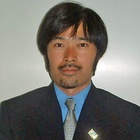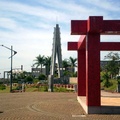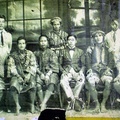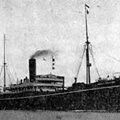Because Japanese community groups and parent’s associations provided the foundation for the management of many of the Nikkei school systems before the war, it was natural for these schools to be established in areas with large Nikkei populations. Here, I would like to provide a general overview of the Taishō Elementary School which was established in the Conde District (Reference Map 2, 3, 4), the first Japantown in Brazil, and the circumstances of those days.
The Taishō Elementary School was founded as Brazil’s first Nikkei school and was located in the heart of the Conde District, on Conde de Sarzedas Street. There were many reasons why Nikkei residents concentrated in this area, including the education of their children. In reality, the education of children was a serious problem not only in the inner-city areas, but to all of the Issei immigrant parents. In “Burajiru Nihon imin 80 nen shi” (80 Years of History of Japanese Immigrants to Brazil - further referenced as “80 years of History”), the educational strategy of Nikkei Issei immigrant parents is summarized as follows.
When a Japanese colony was formed, a Japanese community group was immediately established. Through mutual friendship and cooperation, the group aimed to discuss ways to solve problems within the community. However, the biggest objective/project they faced was the creation of an educational system for their children. Every immigrant parent wished for their children, ones brought to Brazil at a young age and ones born in Brazil, to be taught fundamental Japanese language, knowledge and spirit, so as to not face difficulties when they would return to Japan (Nihon imin 80 nen shi hensann Iinnkai (Editing Comittee for 80 Year History of Japanese Immigration), 1991, pp.60-61).
In other words, dekasegi strategy ideology was still strong at the time and therefore, there existed a need for the education of Brazil-born Nikkei children to become “Japanese.”
Around 1913-14, a man named Jinshirō Tagashira ran a private school on Conde de Sarzedas Street. Shinzō Miyazaki, who later became the first principal, took over the private school from Mr. Tagashira and named it Taishō Elementary School. In Burajiru nihon imin/ Nikkei shakai shi nenpyō -Handa Machio henncho kaitei zōho ban- (Japanese Immigration to Brazil/ Chronology of Japanese Social History -Machio Handa Compilation Expanded Revised Edition - further referenced as “Chronology”), Taishō Elementary School is recorded to have been establish on October 7th, 1915 (São Paulo Center for Japanese-Brazilian Studies, 1996, p.36). In contrast, Naju Suzuki (1941), a pre-Kasato Maru Japanese immigrant, stated that Mr. Miyazaki had already been teaching children at the same location in the 3rd year of the Taishō Era (1914) (p.212). As I later state, the foundation for the management of the school, the Nikkei community’s largest educational facility, was so ambiguous that it is even hard to determine a correct date of establishment. Mr. Suzuki describes the school’s situation as follows.
Taishō Elementary School is located on the right side of the street when going down the Conde hill, and is run in a rented room of an indented, one story building across from Seihachi Kimura’s house. There were only three students at first, and grew to five, then to seven. The monthly tuition fee was three Real. Since the rent for the room was 20 Reais, even when there were seven students, we were able to only just pay the rent (p.214).
Later, Taishō Elementary School relocated to several different places along Conde de Sarzedas Street and in 1919, was finally recognized as a private school by São Paulo City1. The following year, a committee was established, and with the development of the Japantown in the Conde District, the student body grew. The first principal Miyazaki passed away in 1924 and Chiune Yoshiwara was appointed to take his place (Paulista Newspaper, 10/02/1975).
In October of 1928, with the assistance of the São Paulo Japanese School Parent’s Association, founded in the same year, and the full support of the consulate-general, Taishō Elementary School moved to San Joaquin Street, where the Brazil Japanese Cultural Association building now also stands. The move, however, was not a drastic one in that the new location was within the same Liberdade District and only a 10 minute walk from the old location (Reference Map 2). The newly purchased school building had eight classrooms and a staff room on the lower floor, and a boarding house for the school’s parent’s association (Paulista Newspaper, 10/03/1975). From 1932, Japanese teachers with teaching degrees were dispatched to the school through the Ministry of Foreign Affairs and Taishō Elementary School became the central educational facility for Japanese learning in Brazil. Further, major events of the São Paulo Nikkei society such as the four national holidays, starting with tenchōsetsu (the Emperor’s birthday), were held at the school, accompanied by the members of the consulate. In other words, Taishō Elementary School became an institution for the unification of the Nikkei community culture and spirit, as well as the epitome of a native language school for the ethnic community.
According to the chapters, “A Glance at Japanese-Brazilian Elementary Schools” and “Statistics on Boys and Girls of Japanese Elementary Schools” from “Burajiru nenkan” (Brazil Yearbook - 1933), Taishō Elementary School was managed by the Taishō Elementary School Support Group at the time; with two Japanese male teachers and one Brazilian female teacher for a total of three teachers, and 74 male students and 58 female students, for a total of 132 students (p.110, p.117).
Management was transferred to the São Paulo Japanese Assembly Association by the mid-1930s. The school opened a regular course, advanced course, and a school dormitory, increasing its student body to 200 students and its staff to nine teachers. In 1938, a branch school was opened in the Pinheiros Region. Compared to the school’s status when it was in the Conde District, it was quite a leap.
The curriculum consisted of literature (Japanese), ethics, arithmetic, geography, history, science, physical education, and music. Though the textbooks were nationally-sponsored textbooks shipped in from Japan, interviews of alumni and affiliates give the impression of a very liberal educational stance.
Extracurricular activity clubs such as the baseball team, track team, and sumo club were very active. Baseball is a popular sport in Japanese schools and at Taishō Elementary School, the baseball team was one of the first clubs to be created. Around 1924 or 1925 on the field at the bottom of the Conde hill, there was a baseball game between the boys of the Conde city team and the school team of boys 14 years old and younger (Paulista Newspaper, 10/02/1975). At the time, the school team wore shorts and was equipped with hand-sewn pig-leather gloves and hand-made bats. However, by the mid-1930s, baseball equipment was manufactured and sold at a Nikkei sporting goods store. Looking at a photo of the baseball team then, the team is lined up with matching uniforms with the school name “Taisho” on them.
Other extracurricular activities included drama, short plays, and chorus used at the school arts festivals and school plays. Further, there were fieldtrips to outside of São Paulo city and shūgaku ryokō (class excursions) to Rio de Janeiro. GW was a student who went on the 1939 school excursion to Rio. On the way back, the students boarded the newly built ship, Argentina-Maru, and met Yoshie Fujiwara, a tenor singer, during his visit to South America. He agreed to visit Taishō Elementary School and was greatly acclaimed when he demonstrated his beautiful voice to the children. At the time, this type of extracurricular activity and education for the cultivation of aesthetic sensibility was very rare for schools in Brazil. In time, the school alumni would include three members of the United States House of Representatives, cabinet ministers, a director of the Central Bank of Brazil, businessmen, university professors, and school founding-fathers. Further, the children of the Consul and the staff of the consulate were enrolled in the school. It can be said that Taishō Elementary School acted as a sort of cradle for the VIP Nikkei-Brazilians. However, the footsteps of war would soon creep up on this peaceful school life.
Notes:
1. Annotation from “Chronology”: “October 7th, 1915: Taishō Elementary School founded, established at São Paulo City Conde de Sarzedas District 38 (currently 308). Students 3. Founded by teachers such as Shinzō Miyazaki. Though in the fashion of a temple elementary school with three students at first, a committee was established, and the student body gradually grew. In January of 1916, the school moved to Conde District 51 and moved back to 48 in the same year, with 10 students. In January of the 8th year of the Taishō Era (1919), the school became a recognized private school. On January 23rd of the following year, committee established” (p.36)
References:
São Paulo Center for Japanese-Brazilian Studies ed. (1996). Burajiru nihon imin/ Nikkei shakai shi nenpyō -Handa Machio henncho kaitei zōho ban- (Japanese Immigration to Brazil/ Chronology of Japanese Social History -Machio Handa Compilation Expanded Revised Edition). São Paulo Center for Japanese-Brazilian Studies.
Suzuki, Nanju (1941) Umore iku takuto no ashiato (Buried Footprints of Takuto), private press edition.
Nihon imin 80nen shi hensann Iinnkai (Editing Comittee for 80 Year History of Japanese Immigration). Burajiru Nihon imin 80nen shi (80 Years of History of Japanese Immigrants to Brazil) 80 Year Immigration Celebration Committee
Burajiru Jihou Company ed. (1933) Burajiru nenkan (Brazil Yearbook) Burajiru Jihou Company
Newspaper Articles
“Taishō shōgakkō, sono ‘ayumi’ (Life at Taishō Elementary School)” 1-12, Paulista Newspaper, Vol. 6649~6663 (September 30, 1975 ~ October 18, 1975)
© 2007 Sachio Negawa









